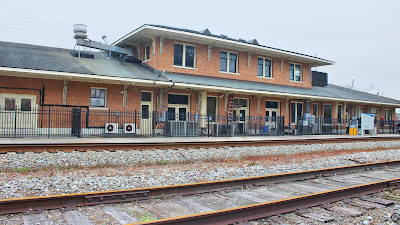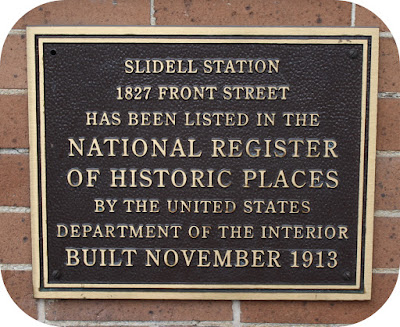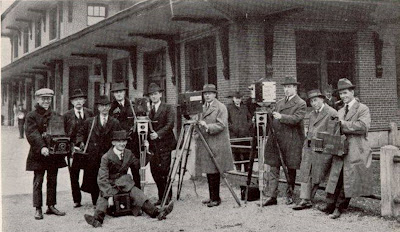There were two train depots in the Slidell area, the northern one which served one railroad, and the main Olde Towne one, which served the other railroad. That is the one we will be talking about in this article. (Eventually the two railroads worked out an agreement and both used this one.)
Today the train station dominates Front Street, offers food and beverages on the north end, community art classes on the south end, and an interesting waiting room and gallery of art in the middle. Tickets are no longer sold there, but the waiting platform still serves passengers from time to time.
Here are some current day photographs of the historic old brick building, followed by an extensive description of its history and improvements.
Click on the images to make them larger. Color Photos by Ron Barthet
The Waiting Room
The waiting room is an iconic American train depot classic, and its walls have been adorned with an impressive array of murals portraying a variety of St. Tammany trains over the years. While during its early years, the waiting room was a key gathering place, access to it is limited now.
The Murals
The murals were painted by Kenny Bridges
The benches are sturdy and individualistic
The Hallway Gallery
In the interior hallway in the depot the walls are lined with interesting artwork, paintings, maps, and portraits of early community citizens.
Commissioner John Slidell, Baron Emile Fredrick d' Erlanger and Matilde Slidell, the Baroness of D' Erlanger
The interior hallway
Local artwork
Maps of area towns by Ron Barthet hanging on the walls
Art Resource Center
On the south end of the depot building is a community art resource center where art and music classes are taught. On display at "Lori's Art Depot" is a wide variety of art styles and motifs, including decorated upright pianos.
To view more pianos (especially the Beatles piano), CLICK HERE
Local residents as well as out-of-town visitors stop in to create their own art.
The art center is run by Lori Gomez (lorigomezart@charter.net) and offers art classes, an art market, music classes, custom gatherings such as birthday parties, even Harry Potter Game Nights. It's an interesting use for the historic train depot building.
The Time Capsule
On the other end of the building is the Time Capsule sealed in 2002.
It is located in front of the other business occupying the train depot, the Times Bar & Grill, a popular place with its own parking lot.
Times Bar & Grill
Historic Registry Application
In 1996, the National Park Service received the application to have the train depot placed on the National Register of Historic Places. It contained a considerable amount of historical detail and a number of black and white photos taken in July of that year.
On the application, the building was called the New Orleans & Northeastern/New Orleans & Great Northern Railroad Depot. The application describes the building as following:
The New Orleans & Northeastern/New Orleans & Great Northern Railroad Depot (1913) is an unstyled, one-story brick structure with a partial second story. Located within the St. Tammany Parish community of Slidell, the building stands west of the town's original business district on an extremely busy north/south thoroughfare known as Front Street.
An active railroad track is situated nearby on the opposite side of the building. Alterations to the building have been relatively minimal, and it remains eligible for National Register listing.
The depot displays horizontal massing and a rectangular footprint broken only by a small first floor bay window facing the railroad track. The structure's low second floor does not extend the entire length of the building, but instead rises above the central section of the first floor somewhat in the manner of a New Orleans camelback house.
Hipped roofs with deep overhanging eaves cover both stories. Large decoratively cut wooden brackets support these eaves. The building's low-slung horizontal massing and the overhanging eaves produce an overall effect reminiscent of the Prairie School style.
Other exterior details include a concrete water table and windows sills, windows containing subdivided upper sashes, and wooden doors. The treatment of the surviving original freight doors is interesting because the individual boards forming them are placed diagonally within rectangular frames.
Passenger and freight facilities are both located on the first floor. The passenger area is the larger of these two spaces. Although slightly altered, its original floor plan is easy to ascertain.
As was typical of the period, it provided for segregated facilities. There are two waiting rooms served by a centrally located ticket office (where the small bay window is located), and four small restrooms.
Three additional spaces possibly served as offices, and there are two small storage rooms with walls made entirely of brick. Interesting features within the passenger section include tongue and groove beaded board ceilings, the placement of wooden members upon concrete walls to create a paneled wainscot, and a screen with geometric designs above one of the interior ticket windows.
The second floor is even more plain than the first. Its original plan consisted of one large open space, as did the plan of the freight section. Of interest in the latter is the roof which is supported by a series of large laminated wooden beams and braces. A narrow concrete platform adjoins the building's north (freight) side.
Alterations to the depot have been relatively minimal. They include the subdivision of both waiting rooms and the second floor space, the subdivision of the freight area to create a small office, the installation of dropped tile ceilings and tile floors in the passenger section, the replacement of two original sliding freight doors with doors which rise like garage doors, the covering of a few windows with wooden panels, and the loss of a wooden freight platform connected to the building.
None of these changes seriously impacts the building's historic identity as a railroad depot. Thus, the depot would be easily recognized by any railroad employee, passenger, or Slidell citizen from the historic period when the railroad made possible the industries which formed the mainstay of the local economy.
The Ticket Window in 1996
Historic Overview
The New Orleans & Northeastern/New Orleans & Great Northern Railroad Depot is locally significant in the area of transportation because it represents a very important force in the history of the town of Slidell.
Although the present depot does not represent the founding of Slidell by the New Orleans and Northeastern Railroad (N.O. & N.E.) in the 1880s or the arrival of a second line, the New Orleans & Great Northern (N.O. & G.N.), in 1905, it does represent railroading as a crucial force in the town's economy from its 1913 construction date through 1946, the fifty year cutoff (The railroad continued to be the principal method of transporting goods into the post-World War II era. A portion of the depot is still in use as an Amtrak terminal).
Research in available primary and secondary sources has failed to answer the question of whether the New Orleans & Northeastern Railroad or the New Orleans & Great Northern Railroad actually built the 1913 Slidell depot.
A captioned photograph published in the St. Tammany Farmer at the time of the depot's completion credited its construction to the Great Northern. However, Sanborn Fire Insurance Maps for 1911 and 1926 indicate that both companies used the tracks which ran through Slidell and terminated in New Orleans after crossing Lake Pontchartrain.
Slidell was one of the last towns to be founded in St. Tammany Parish. Its birth coincides with the construction of the N.O. & N.E., which was organized in 1881 with the twin goals of opening the eastern portion of St Tammany Parish to development and linking southeast Louisiana with the northeastern United States.
Apparently, the site which became Slidell first served as a camp for railroad construction workers. The company actually surveyed the townsite when rail service began in 1883. The community was named after Confederate diplomat John Slidell, whose European son-in-law was a principal investor in the railroad.
Although telephone and telegraph communication were established in 1884, the community did not incorporate until 1889. Census records indicate that the town had grown from 364 persons in 1890 to 1,129 in 1900.
Late nineteenth century businessmen were seldom satisfied with only one rail connection to outside markets, and residents of Slidell were no exception. Thus, they welcomed the 1905 chartering of the New Orleans and Great Northern, whose goal was to establish a rail link between New Orleans and Jackson, Mississippi.
This line also contributed to the town's growth, with the population reaching 2,188 in 1910 and 2,958 in 1920. By then Slidell was the largest town in the parish.
This growth was spurred by the presence in Slidell of several businesses which were dependent upon the two railroads for transportation of their products to outside markets. The first was a creosote company which was originally founded to treat the many pilings and crossties needed to build a railroad bridge across Lake Pontchartrain. Sanborn Fire Insurance maps for the historic period indicate that it was a large concern and, thus, an important source of employment for the community's residents.
In January of 1922, numerous press photographers gathered at the train station to take pictures of the thousands of guests arriving for the wedding of Ella Rose Salmen, daughter of Fritz Salmen,
to William H Sullivan, founder of the city of Bogalusa and The Great
Southern Lumber Company. Guests arrived on trains from "various states
South and East" as one newspaper described it.
Another significant and long-lived business was the Slidell Grocery and Grain Company. However, the largest and most important of these businesses was the Salmen Brothers Brick and Lumber Company, which operated from 1887 until the 1920s. Sanborn maps clearly indicate the company's role as the economic basis for Slidell's survival during the community's early years. Later in the twentieth century, a Coca Cola Bottling works, a Texaco oil depot, and a manufacturer which extracted oils from wood also located along the line.
The relationship between the railroad industry and these businesses is vividly portrayed in the Sanborn maps. Because all of these businesses needed the fast and relatively inexpensive transportation which the railroad could provide, each was located directly adjacent to the track which the two railroad companies shared.
As a result, the track line served as a manufacturing corridor similar to today's modern industrial parks. In addition, most of the Slidell businesses mentioned above had a number of spur lines on their properties.
These lines connected specific buildings where products were stored to the main track, eliminating the need for the expensive extra step of transporting products to the local depot for shipment.
Because the two railroads were critical to Slidell's economy, as described above, the depot is obviously of considerable significance in the town's history. It is the very symbol of the railroad and what it made possible.
Thus, the New Orleans & Northeastern\New Orleans & Great Northern Railroad Depot was a strong candidate for National Register listing.
The parcel of land included with the depot when the building was donated to the City of Slidell is of an unusual size and shape. It is well over 700 feet long but only roughly 50 feet wide. The boundaries chosen for this nomination follow the property lines on the depot's east and west sides and are cut close to the building on the north and south in order to exclude unnecessary acreage.
That concluded the text narrative on the historic registry application.
Slidell Train Station Stats
Extensive information about the Slidell train depot can also be found over at the Great American Stations website. Here is the description offered on the webpage about Slidell.
According to the Great American Stations website, the Slidell Train Station was renovated in the 1990s to house a waiting room and commercial spaces. The depot connects Olde Towne Slidell, known for its shops and restaurants, with popular Robert's Landing Park.
"The brick Olde Towne Railroad Depot in Slidell was built around 1903 for the New Orleans & Northeastern/New Orleans & Great Northern railroad, supplanting an earlier wooden passenger depot which was located on the west side of the tracks between Maine and Pennsylvania Streets. In the early 1990s, the city of Slidell submitted a grant application to the Louisiana Department of Transportation and Development (LDOTD) to receive funding under the Intermodal Surface Transportation Enhancement Act (ISTEA) of 1991 to renovate, preserve and operate the depot.
"Before renovations began, the Norfolk Southern Railway donated the depot and about two acres of land to the city, and resolutions were made authorizing the mayor to enter into agreements with the LDOTD for depot renovation. Later that same year, the building was put on the National Register of Historic Places, protecting the historic character of the building.
"Renovations to the depot were made in three phases. Phase I funding consisted of the $204,000 ISTEA grant matched by $56,000 of city sales tax funds, and was completed in less than a year. N-Y Associates Inc. /Architects, Ltd. performed the design and Edel Construction did the work, including replacement of the roof and support beams, replacement of windows, lead paint abatement, new electrical service, and installation of the trunk line for the fire suppression sprinkler system. Additionally, 90 years of neglect was cleaned from the interior.
"Phases II and III were funded by $200,000 from the state and $200,000 in city funds, and continued the gutting and rebuilding of the station to compliment the Olde Towne street landscaping that was underway. The Amtrak office, waiting room, and rest rooms take up about 1,000 square feet of the station today. Also currently located in the depot are two restaurants, the Times Bar & Grill and the Beignet Station.
"The city successfully established an Olde Towne–Train Depot–Robert’s Landing Park connection that served to revitalize the city’s older core. However, it was fall of 2006 before the city had recovered sufficiently from Hurricane Katrina’s ravages to begin to pick up with its cultural life in Old Towne as before.
"About three miles from the north shore of Lake Pontchartrain, scattered houses had been built near Robert’s Landing as early as 1852; the landing allowed the Spanish, French, and later, Americans to travel by boat along the bayou Bonfouca to Lake Pontchartrain. The need for better overland transportation to the north and east of New Orleans, however, encouraged the New Orleans and Northeastern Railroad to build through the present site of Slidell, at Roberts’ Landing, and continuing on to Jackson, Mississippi. The first survey team came in 1881 and the first train traveled along that line through the area on October 15, 1883.
"In 1883, railroad surveyors mapped the town and named it Slidell Station in honor of John Slidell, a U.S. Senator and Confederate official. The Town of Slidell was incorporated on November 3, 1888, and it enclosed about 2,320 acres. The railroad, from 1903 through 1946, formed the mainline of Slidell’s prosperity. In the thirty years after its founding, Slidell developed a creosote plant, one of the country’s largest brick manufacturing facilities, a large lumber mill, and a shipyard—which contributed significantly to the national efforts in both world wars. Slidell boomed in the 1960s due to the location of NASA’s Slidell Computer Complex there, in 1962, to support the Stennis Space Center in Mississippi and the Michoud Assembly Center in New Orleans."
In the numbers section of the article it noted that Annual Station Revenue (FY 2018) was $874,986, and Annual Station Ridership (FY 2018) was 9,100. To visit the Slidell train station webpage on Great American Stations, CLICK HERE.
The website also offers a number of ideas of preserving old train stations as historical landmarks. CLICK HERE to go to that page.
Train petitions to stop only when passengers are boarding
-------------------------------------------------
A number of great pictures showing trains at the Slidell Train Depot can be found at the http://www.rrpicturearchives.net. Click here to go to the entire collection. Here are a few samples from that website.
Early Photos of the Slidell Train Depot
Slidell Flag Plaza
For a PDF File of this article, CLICK HERE.



















































